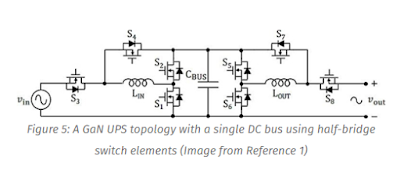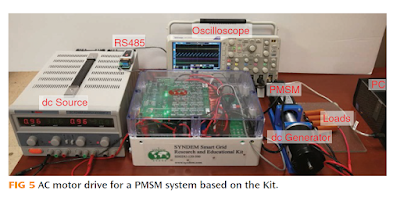Characteristic Improvement of a Bridgeless PFC Converter by using SiC SBDs Joon-Hyeok Jeon, Sin-Su Kyoung, Hee-Jun Kim Powercubesemi, Inc.*, Hanyang University
terça-feira, 29 de dezembro de 2020
Characteristic Improvement of a Bridgeless PFC Converter by using SiC SBDs Joon-Hyeok Jeon, Sin-Su Kyoung, Hee-Jun Kim Powercubesemi, Inc., Hanyang University
Characteristic Improvement of a Bridgeless PFC Converter by using SiC SBDs Joon-Hyeok Jeon, Sin-Su Kyoung, Hee-Jun Kim Powercubesemi, Inc.*, Hanyang University
sábado, 26 de dezembro de 2020
Review:Uninterruptible Power Supply(UPS)System Muhammad Aamir,Kafeel Ahmed Kalwar,Saad Mekhilef Power Electronics and Renewable Energy Research Laboratory(PEARL),Department of Electrical Engineering,University of Malaya,Kuala Lumpur Malaysia
Review:Uninterruptible Power Supply(UPS)system Muhammad Aamir,Kafeel Ahmed Kalwar,Saad Mekhilef Power Electronics and Renewable Energy Research Laboratory(PEARL),
terça-feira, 22 de dezembro de 2020
DESENVOLVIMENTO DE UPS TRIFASICA DE ALTO RENDIMENTO UTILIZANDO MOSFETS DE CARBONETO DE SILICIO AUTOR WENDELL DA CUNHA ALVES PROGRAMA DE PÓS-GRADUAÇÃO EM ENGENHARIA ELETRICA UNIVERSIDADE FEDERAL DE MINAS GERAIS BRASIL
Resumo
A SiC MOSFET Based High Efficiency Interleaved Boost Converter for More Electric Aircraft Haider Zaman†, Xiancheng Zheng, Mengxin Yang, Husan Ali, and Xiaohua Wu,School of Automation, Northwestern Polytechnical University, Xi’an, China
A SiC MOSFET Based High Efficiency Interleaved Boost Converter for More Electric Aircraft Haider Zaman†, Xiancheng Zheng*, Mengxin Yang*, Husan Ali*, and Xiaohua Wu* †,*School of Automation, Northwestern Polytechnical University, Xi’an, China
Abstract Silicon Carbide (SiC) MOSFET belongs to the family of wide-band gap devices with inherit property of low switching and conduction losses. The stable operation of SiC MOSFET at higher operating temperatures has invoked the interest of researchers in terms of its application to high power density (HPD) power converters. This paper presents a performance study of SiC MOSFET based two-phase interleaved boost converter (IBC) for regulation of avionics bus voltage in more electric aircraft (MEA). A 450W HPD, IBC has been developed for study, which delivers 28V output voltage when supplied by 24V battery. A gate driver design for SiC MOSFET is presented which ensures the operation of converter at 250kHz switching frequency, reduces the miller current and gate signal ringing. The peak current mode control (PCMC) has been employed for load voltage regulation. The efficiency of SiC MOSFET based IBC converter is compared against Si counterpart. Experimentally obtained efficiency results are presented to show that SiC MOSFET is the device of choice under a heavy load and high switching frequency operation.
Key words: High Power Density (HPD), Interleaved Boost Converter (IBC), More Electrical Aircraft (MEA), Peak Current Mode Control (PCMC), Silicon Carbide (SiC)
LINK:https://jpels.org/digital-library/manuscript/file/15794/03_JPE-17-06-083.pdfAnalysis and Implementation of a New Single Switch, High Voltage Gain DC-DC Converter with a Wide CCM Operation Range and Reduced Components Voltage Stress Babak Honarjoo*, Seyed M. Madani†, Mehdi Niroomand*, and Ehsan Adib
Analysis and Implementation of a New Single Switch, High Voltage Gain DC-DC Converter with a Wide CCM Operation Range and Reduced Components Voltage Stress Babak Honarjoo*, Seyed M. Madani†, Mehdi Niroomand*, and Ehsan Adib
Department of Electrical and Computer Engineering, Isfahan University of Technology, Isfahan, Iran
Abstract This paper presents a single switch, high step-up, non-isolated dc-dc converter suitable for renewable energy applications. The proposed converter is composed of a coupled inductor, a passive clamp circuit, a switched capacitor and voltage lift circuits. The passive clamp recovers the leakage inductance energy of the coupled inductor and limits the voltage spike on the switch. The configuration of the passive clamp and switched capacitor circuit increases the voltage gain. A wide continuous conduction mode (CCM) operation range, a low turn ratio for the coupled inductor, low voltage stress on the switch, switch turn on under almost zero current switching (ZCS), low voltage stress on the diodes, leakage inductance energy recovery, high efficiency and a high voltage gain without a large duty cycle are the benefits of this converter. The steady state operation of the converter in the continuous conduction mode (CCM) and discontinuous conduction mode (DCM) is discussed and analyzed. A 200W prototype converter with a 28V input and a 380V output voltage is implemented and tested to verify the theoretical analysis.
Key words: Coupled inductor, High step-up voltage gain, Single switch, Switched capacitor, Low voltage stress
LINK: https://jpels.org/digital-library/manuscript/file/15793/02_JPE-17-04-091.pdf
quarta-feira, 16 de dezembro de 2020
INDUSTRIAL UPS WITH WIDE BANDGAP (WBG) POWER TRANSISTOR devices enable smaller, lighter-weight and more efficient systems
Enter a GaN soft-switching transformer-less online UPS topology which enables significant size reduction by operating efficiently at high switching frequencies using GaN power devices. See Figure 5, at right.
The proposed UPS employs standard GaN half-bridge structures with a common-neutral between the input and output and is able to achieve zero-voltage switching (ZVS) operation, in the boundary conduction mode, with no additional complex circuit design. This design employs a new control methodology for the UPS that has a dual-mode digital controller for the input PFC rectifier stage. The digital controller regulates the output voltage of the converter across both resistive and reactive loads.
The inverter (DC/AC) stage is also operated in dual-mode, and a digital controller regulates the output voltage of the converter across resistive and reactive loads. This converter architecture is capable of delivering 1-kVA of output power while maintaining unity power factor at its input. This GaN-based 1-kVA online UPS is operated using the proposed control technique in Reference 1, and is designed, built, and tested. The prototype UPS, operated up to 2MHz, achieved a power density of 26.4W/in3.
References
1-Control of a GaN-Based High-Power-Density Single-Phase Online Uninterruptible Power Supply, Danish Shahzad, Saad Pervaiz, Nauman Zaffar, Khurram K. Afridi, IEEE 2019
2- Performance Comparison of 1200V Silicon and SiC devices for UPS Application, James McBryde, Arun Kadavelugu, Bobby Compton, Subhashish Bhattacharya, Mrinal Das, Anant Agarwal, IEEE 2010
LINK ORIGINAL:https://gan-sic-power.richardsonrfpd.com/applications/application-industrial-ups/
domingo, 13 de dezembro de 2020
Go Real: Power Electronics From Simulations to Experiments in Hours Versatile experimental tool for next generation engineers by Qing-Chang Zhong, Yeqin Wang, Yiting Dong, Beibei Ren, and Mohammad Amin
segunda-feira, 7 de dezembro de 2020
Development of AC–DC Converter with 10V and 10,000A Output for Sintering -Koji Orikawa,Jun-ichi Itoh-Nagaoka University of Technology
Development of AC–DC Converter with 10-V and 10,000-A Output for Sintering Koji Orikawa∗ Student Member, Jun-ichi Itoh∗ Member-Nagaoka University of Technology
(Manuscript received Dec. 30, 2011, revised June 3, 2012) IEEJ Journal of Industry Applications Vol.1 No.3 pp.164–171
This paper discusses a high-efficiency AC–DC converter developed for implementation under low-voltage and high- current conditions for sintering applications. First, the circuit configuration and the control principle for the proposed low-voltage, high-current AC–DC converter are described. The proposed system consists of four 2,500-A units of the AC–DC converter connected in parallel. The input current harmonics are suppressed by using multiple transformers on the input side. Further, imbalance issues in the transformer parameters and the output wiring are discussed. The proposed system demonstrates that each individual circuit yields a balanced 2,500-A output. In addition, loss analysis shows that the power loss on the secondary rectifier is 49% and is dominated by semiconductor loss. Furthermore, it is shown that by implementing a MOSFET synchronous rectifier, instead of a Schottky barrier diode, the loss reduces by 35%. Finally, the input current harmonics are reduced by using multiple transformers, and the validity of this result is demonstrated.
Keywords: sintering, low-voltage high-current, synchronous rectifier
LINK:https://www.jstage.jst.go.jp/article/ieejjia/1/3/1_164/_pdf/-char/en
A novel MPPT algorithm considering solar photovoltaic modules and load characteristics for a single stage standalone solar photovoltaic system Hwa-Dong Liu , Chang-Hua Lin , and Shiue-Der Lu-Department of Electrical Engineering, National Taiwan University of Science and Technology
quarta-feira, 2 de dezembro de 2020
ESS 기능을 갖는 하이브리드 UPS-Hybrid UPS with Energy Storage System Function Seung-Beom Lim✝ and Soon-Chan Hong-School of Electronics and Electrical Engineering, Dankook University
LINK: http://www.koreascience.or.kr/article/JAKO201419553341244.pdf
Practical Design Methodology of Dual Active Bridge Converter as Isolated Bi-directional DC-DC Converter for Solid State Transformer Hyun-Jun Choi, Won-Bin Lee, and Jee-Hoon Jung
Solid State Transformer를 위한 양방향 Dual Active Bridge DC-DC 컨버터의 설계 기법 최현준1, 이원빈1, 정지훈✝
terça-feira, 1 de dezembro de 2020
Low Cost and High Performance Single Phase UPS Using a Single-Loop Robust Voltage Controller Jun-Keun Ji†, Dae-Kwan Ku*, and Seung-Beom Lim** †Department of Electrical Engineering, Soonchunhyang University, Asan, Korea
Department of Electrical Engineering, Soonchunhyang University, Asan, Korea *VCTech Co., Ltd., R&D Center, Gunpo, Korea **EON Co., Ltd., R&D Center, Anyang, Korea
Abstract
Uninterruptible Power Supplies (UPSs) can be largely divided into the passive-standby, line-interactive and double-conversion methods. This paper proposes a double-conversion UPS with a low cost and high performance. This single phase UPS uses a single-loop robust voltage controller and 1-switch voltage doubler strategy PFC. The proposed UPS is composed of a single phase PFC, a half-bridge inverter, a battery charger and a battery discharger. Finally, the validity of proposed UPS was verified by various experimental tests. Key words: 1-switch voltage doubler strategy PFC, Low cost and high performance, Single phase UPS, Single-loop robust voltage controller
LINK FULL PAPER:
http://www.koreascience.or.kr/article/CFKO201136262564307.page
LINK :Design of Robust Voltage Controller for Single-phase UPS Inverter 단상 UPS 인버터의 강인한 전압제어기 설계 Ku, Dae-Kwan ; Ji, Jun-Keun ; Cha, Guee-Soo ; Moon, Jun-Hee
http://www.koreascience.or.kr/article/JAKO201128563050510.page
LINK: Hybrid UPS with Energy Storage System Function Seung-Beom Lim✝ and Soon-Chan Hong
http://www.koreascience.or.kr/article/JAKO201419553341244.pdf
sexta-feira, 27 de novembro de 2020
sexta-feira, 20 de novembro de 2020
Research Institute Uninterruptible power supply UPS 75KVA (3Ø 4W 380V) PCB BOARD, IGBT, DC capacitor, AC capacitor, blower fan, fan replacement work.
Research Institute Uninterruptible power supply UPS 75KVA (3Ø 4W 380V) PCB BOARD, IGBT, DC capacitor, AC capacitor, blower fan, fan replacement work.
quinta-feira, 19 de novembro de 2020
Fonte ininterrupta de energia trifásica de alto desempenho sem transformador com dupla funcionalidade do estágio de entrada e sistema de controle digital-Venturini, William Alegranci- Dissertação (Mestrado em Engenharia Elétrica) - Universidade Federal de Santa Maria, Santa Maria, 2016.
VENTURINI, William Alegranci. High performance three-phase transformerless uninterruptible power supply with double functionality of the input stage and digital control system. 2016. 222 f. Dissertação (Mestrado em Engenharia Elétrica) - Universidade Federal de Santa Maria, Santa Maria, 2016.
RESUMO
Esta dissertação de mestrado propõem uma topologia de fonte ininterrupta de energia (UPS - Uninterruptible Power Supplies) trifásica de dupla conversão sem transformador com custo reduzido e sistema de controle digital. A UPS proposta é composta por um estágio de entrada, um banco de baterias, um inversor, um circuito auxiliar e chaves de transferência. O estágio de entrada assume a função de retificador trifásico com filtro LCL em modo normal de operação da UPS e é responsável pela descarga do banco de baterias em modo bateria de operação. Esta configuração reduz o custo do sistema, pois permite que seja aproveitado um circuito disponível e dimensionado para a potência nominal da UPS para a descarga do banco de baterias. Em topologias convencionais de UPSs de dupla conversão o estágio de entrada permanece ocioso durante este modo de operação e um circuito adicional é empregado para este fim. O circuito auxiliar é formado por um indutor e um braço de interruptores e é utilizado como carregador de baterias em modo normal de operação e adicionalmente é utilizado para realizar o equilíbrio das tensões dos capacitores de barramento em modo bateria. Com esta configuração, o circuito auxiliar pode ser dimensionado para apenas uma fração da potência nominal da UPS, propiciando também a redução do custo total do sistema. As chaves de transferência alteram as configurações do estágio de entrada e do circuito auxiliar de acordo com o modo de operação da UPS. É apresentada a operação detalhada da topologia, a modelagem, a estrutura de controle digital utilizada e os resultados obtidos via simulação. Por fim, um protótipo de 20 kVA é implementado e resultados experimentais são adquiridos para a validação da metodologia de projeto empregada bem como da funcionalidade do circuito proposto.






























































































 JOSIL ARTISTA PLASTICO FORTALEZA CEARA BRASIL AV.HERACLITO GRAÇA 41 TEL(85)32542378
JOSIL ARTISTA PLASTICO FORTALEZA CEARA BRASIL AV.HERACLITO GRAÇA 41 TEL(85)32542378















